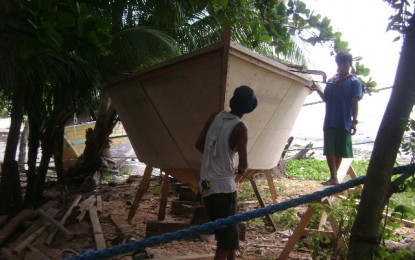
ZAMBOANGA CITY -- In a coastal barangay located 35 kilometers from downtown Zamboanga City, one could witness a craft that has existed in the region since time immemorial -- boatbuilding.
The boatyard there is one of a handful that can be found along the city’s long coast, including in one island.
Since local pre-history, the inhabitants have been building a great variety of wooden boats used for fishing, trading and rituals, among others.
According to legend, the first royal datus in the country traveled by boats from Indonesia to establish pre-Islam and pre-Spanish sultanates in different parts of the archipelago.
A Tausug sultan, centuries ago traveled by boat -- likely a parao or long balanghai -- to China to visit the kingdom’s emperor.
Tausug in English means “people of the current”. The Badjaos are called sea nomads who until recent times lived in houseboats all their life.


The Sangali boatyard is located in Sitio Malasugat, along a large cove where the Zamboanga Fishing Port Complex and an adjacent ship repair yard -- a varadero -- are also found.
The cove teems with many fishing boats that unload catches bound for refrigeration plants of the complex, to be shipped out to other provinces in Mindanao or the extras or rejects to be sold in local markets.
At the boatyard a few days before Christmas, shipwright Embass Abdurasid and his assistant rushed to finish a wooden-hulled “tempel”, a fast-running type of boat.
The boat is 48 feet long, 11 feet deep from gunwale (topside) to keel (or spine), and five feet from side to side at widest point.
The ribs are made of thick lauan boards bolted together to form the boat’s V shape body, though the rear is flat bottomed to give stability to the seacraft.
Embass said the body’s skin is made of three-eight (inch) waterproof marine plywood nailed to the ribs and caulked with epoxy to seal out the seawater.
When the main body is finished, Embass said he will also build a pilot house and flooring, which will be waterproof.
Another contractor will do the painting, and another one will install the engine and other navigational accessories.
The engine is a marine diesel with a 90-horsepower capacity, he said.
Embass said it will take him three months to finish the construction. The boat is owned by a Tausug businessman who will utilize it to ferry cargo and passengers between Jolo and nearby islands in Sulu province.
Embass said wooden boats are preferred in the region than boats made of fiberglass.
Fiberglass, he said, is prone to cracking in the tropical sun of the region.
Near the area where Embass is building his boat are two newly finished tempels, too, both seemingly ready to challenge the Sulu Sea.
Other types of wooden motorboats common in the region are the kumpit, junkung and lepa-lepa.
The kumpit are normally large enough to carry tons of cargo (like smuggled rice from Malaysia) or company-size passengers.
Today, they compete with steel-hulled motor launches that ply around the archipelagic region including Sabah ports.

The junkung is usually bigger than the tempel but smaller than the kumpit, is used to ferry passengers or cargo between shorter distances. The Moro rebels who attacked Zamboanga in 2013 rode a junkung from Sulu to the city.
The lepa-lepa (or simply lepa) is a round-bottom tempel-size craft native to Tawi-Tawi and more commonly found there, popular to the local Samas.
Once upon a time, the Badjaos used paddles to move them around as their houseboat. Now, there are bigger versions that use inboard engines as commercial vessels.
Their round bottom makes them almost impervious to capsizing, sliding from wave to wave even in a heaving sea.
Other types of boats seen in the region is the basnig, kulibo, buggoh, and the iconic vinta.
The basnig is a slim-built fishing boat with outriggers and tall masts. The kulibo is a small fishing boat with short outriggers and fitted with an inboard engine. The buggoh is a banca that uses a paddle to move about and is called a pumpboat if powered by an engine instead of paddle. The vinta is a sailboat, often romantically portrayed in seascape photos about the region. (PNA)
